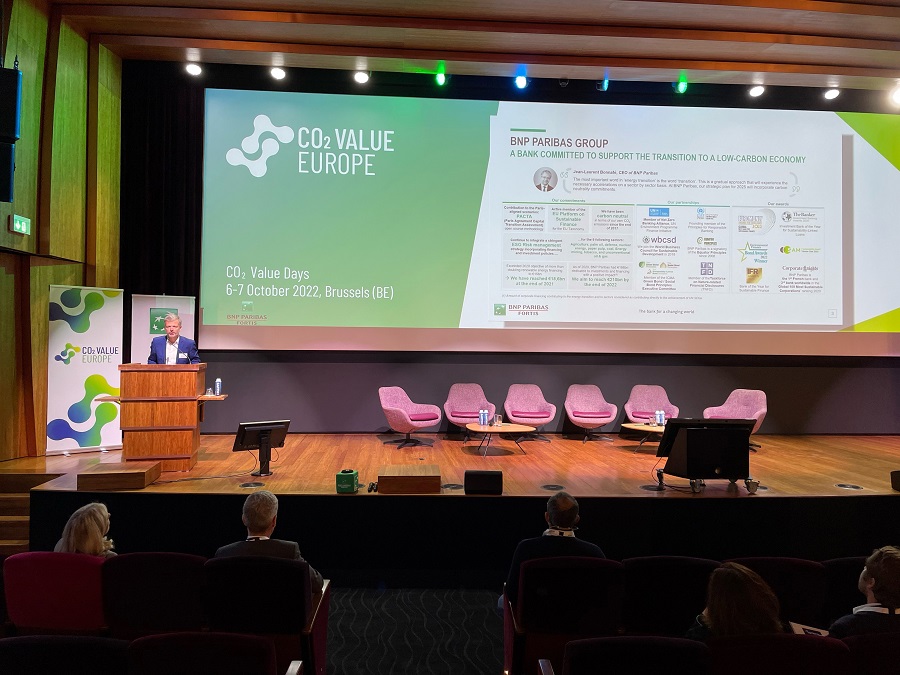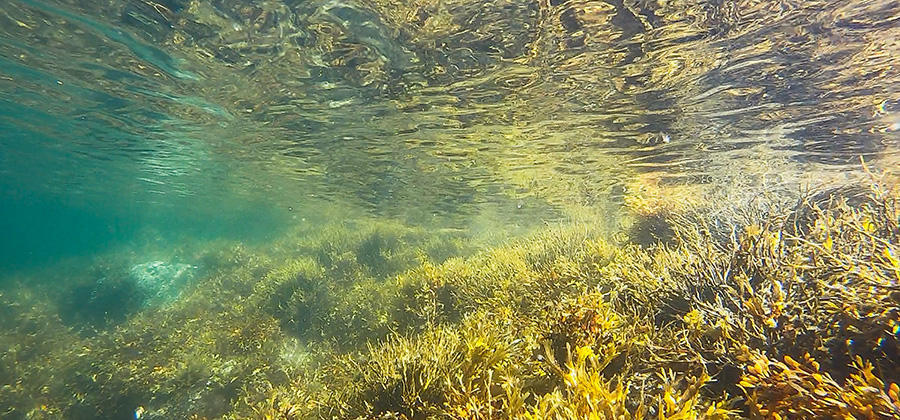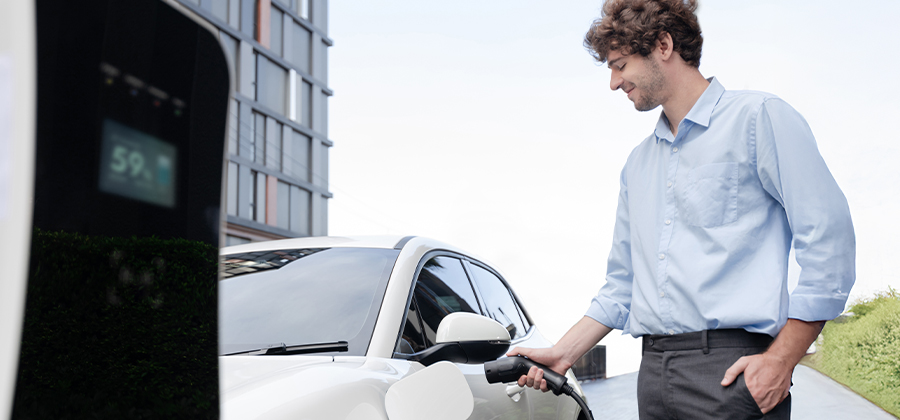From sustainable footpaths to fashionable dress to sophisticated e-fuel. At their annual meeting, CO2 Value, a partner organisation of BNP Paribas Fortis, illustrated very concretely how carbon capture and utilisation can help defossilise the economy.

It’s simple, in fact. Forests and oceans can absorb CO2 that is released. But fossil fuel combustion, industry and land use create so much CO2 that nature can no longer handle that absorption. The result is global warming. So we need to reduce CO2 emissions and use more renewable energy. That solution is unfortunately less straightforward in practice, although there are already many promising technologies to accelerate decarbonisation. And that is exactly what CO2 Value Europe is working towards.
Circular carbon economy
CO2 Value Europe, a partner organisation of BNP Paribas Fortis, is an inter-professional organisation representing the Carbon Capture & Utilisation (CCU) community in Europe. It strives for a circular carbon economy. It seeks alternative ways and technologies to capture CO2 and then recycle it into usable sustainable raw materials for fuels, chemicals and building materials, among others.
Crash course in CCU
The audience at this year's sixth edition of CO2 Value's annual meeting was just a little more diverse than usual. Besides members, interested companies and clients of BNP Paribas Fortis were also able to attend the meeting. And they did so in large numbers. Carbon capture and utilisation is a hot topic. A lot of companies are facing a sustainable transition and want to decarbonise. Attendees were given a crash course in 'What is CCU?', but it was mainly the concrete applications that really appealed.
Sustainable footpath
VITO, a Flemish independent research organisation in the field of cleantech and sustainable development, gave an example of how CO2 mineralisation can make the construction sector more sustainable. This technology not only leads to lower CO2 emissions, but permanently stores carbon dioxide in valuable products such as bricks and many other building materials. In Ghent, for example, there is already a footpath made of sustainable bricks.
Dress to impress
CCU can also make a difference in the fashion sector, LanzaTech proves. They convert carbon waste into sustainable fuels, fabrics, packaging and other products that people use in their daily lives. One of these is a synthetic fibre to make clothes that are sustainable without sacrificing anything in terms of comfort or style.
E-methane
Fossil fuels remain a major source of CO2. With the Colombus project, Engie, Carmeuse and John Cockerill are joining forces. They are developing an alternative fuel that will help decarbonise industry and the transport sector. CO2 released during lime production is captured by Carmeuse and then combined with green hydrogen from Engie. Based on this, John Cockerill produces carbon-neutral synthetic methane or e-methane via electrolysis as an alternative to fossil fuels. This is a great example of a circular carbon economy.
Sustainable partnership
As a partner from the very beginning, BNP Paribas Fortis is 100% behind CO2 Value's mission. Sustainability is in the bank's DNA, so we certainly encourage a new circular and industrial value chain. As a banker, we take our responsibility seriously and are happy to help develop innovative solutions that make our economy more resilient and sustainable.
Want to know more? Visit the CO2 Value Europe website.
15.01.2021
In the future, will we use CO² to build?
It sounds somewhat futuristic, but today building with CO² is possible. Thanks to accelerates carbonation, CO² is used to produce building material. A sustainable footpath in Ghent illustrates how promising this new technology is.
In mid-December, CO2 Value Europe, a think- and do- tank representing the carbon capture and utilisation (CCU) community in Europe, held a webinar about the use of CO2 to create building material. Concrete examples of this sustainable technology were given to illustrate the potential they can offers, especially in the hard-to-abate construction sector. BNP Paribas Fortis and CO2 Value Europe are partners in issues related to financing innovative and sustainable technologies. As an institution, we work hard to promote corporate sustainability.
The second-most polluting industrial sector
As well as being one of the largest in the world, the cement industry's high levels of flue gas emissions also make it one of the most polluting. Cement is a crucial component in concrete, which is vital for the building sector. A sustainable alternative to cement could make a huge difference. One option here is carbonation, also known as CO2 mineralization. While this CCU technology is not yet well known, it has the potential to play a crucial role in mitigating climate change.
Giving nature a helping hand
Carbonation is a natural process, where minerals react with CO2 to create e.g. limestone and dolomite. In nature, this process takes thousands of years, but today, thanks to innovative methods, this time can be cut down to some minutes. This process requires relatively small amounts of energy and can be used to create several different products, including bricks where CO2 is sequestered permanently.
CO2 all the way
The development of CCU technology has accelerated sharply in recent years. We now have cement alternatives that meet the building sector’s technical requirements. There are various ways to store CO2 into construction materials. For example, CO2 can be injected as an alternative to water for hardening cement. What’s more, CO2 can be used to convert mineral waste from steel and mining industries into new products such as aggregates, which can be used as a basis for paving or building blocks.
Good for the planet
Mineralization of CO2 has a significant impact on the environment, because it has an effect at different levels. The annual global reduction in CO2 emissions is estimated to be 250 - 500 million tonnes by 2030 (source CO2 Value Europe).
- CO2 can be captured from flue gas emitted by industrial processes used to create steel, cement, and chemicals, with no need for concentration or treatment.
- CO2 can be captured directly from the atmosphere to create negative carbon emissions, i.e. carbon removal.
- In both cases, the CO2 will be stored permanently in building materials.
- Mineral waste and even construction waste are used together with CO2 to make new building materials, so it reduces landfills and the associated costs.
- Recycling carbon and construction wastes means fewer new natural resources are exploited.
What’s the catch?
New developments are never without their challenges, and this is no exception. Offering a competitive, quality alternative to concrete in a circular economy requires investment and adaptation.
- Factories will have to adapt their plants. Locating them close to significant sources of CO2, like a steel factory, is recommended so the CO2 and the waste fractions do not have to be transported.
- Manufacturing new products takes energy and creates CO2 emissions, even if the products are made using carbon dioxide and waste. It is why renewable energy should be used as much as possible to increase the sustainability of the processes.
- The commercialization of accelerated carbonation technologies is quite recent, and some processes are not optimally equipped for this yet.
- The lack of appropriate regulatory frameworks is also a drawdown to allow for a fast deployment of CCU technologies. This is an area CO2 Value Europe is especially working on.
Despite these challenges, Andre Bardow (Professor of Energy & Process Systems Engineering, ETH Zurich) told us during the webinar that he is convinced CO2 mineralization reduces the CO2 footprint from a life cycle perspective, even more than carbon capture and storage (CCS).
Zero domestic waste
There are already companies producing low-CO2 construction materials around the world. One of them is in Limburg. Orbix, in Genk, has successfully extracted minerals from steel production waste (known as slag) which are used as a basis for eco-friendly concrete stone. Not only is liquid CO2 used to produce concrete stone rather than polluting cement, but residual waste that would otherwise be dumped in landfill is also recycled.
There is a great example of this in Ghent, where Orbix worked with the Flemish research institute VITO to create the Stapsteen project for the city. Visitors can walk on Belgium’s first-ever circular economy footpath in the Leewstraat: 100m2 made entirely from sustainable bricks, saving a full 2 tonnes of CO2.
Do you have sustainability plans for 2021? Our experts at the Sustainable Business Competence Centre can provide advice about innovations like CO2 mineralisation and support your sustainable transition.
25.02.2021
How can the blue economy make a difference?
What if the future of sustainable business is at the bottom of the ocean for once? Marine biodiversity contains resources that can meet the environmental challenges of many sectors. Perhaps yours, too. Find out more during an online event about the promising blue economy on 11 March 2021.

Blue is the new green
71% of our planet consists of water. Seas and oceans play a crucial role in our climate, and coastal areas can capture up to five times more CO2 than tropical forests. The blue economy wants to benefit from all these advantages to improve both the environment and our well-being,
With local being the keyword. And that's where the difference lies with the green economy, which also focuses on the environment and health, but not always in such a sustainable and smart way. Eating organically grown quinoa from Ecuador, for example, is healthy and eco-friendly, but transporting it here is expensive and creates high amounts of pollution.
Offshore sustainability
What does the underwater world have to offer that can be reused, recycled or converted into new sustainable products? A lot, it turns out, as the unique properties of organisms such as algae, starfish, jellyfish or sea cucumbers can be transformed into sustainable products with high added value. This is a process that requires creativity and innovation, and is already with us today.
For your sector, too
The blue economy is expanding rapidly and could bring about a revolution in a wide range of sectors such as healthcare, food, the plastics industry, cosmetics, energy and even aerospace. It is fully capable of helping companies transform their traditional activities into a sustainable model. And in Belgium's ports, the country already has a huge advantage and excellent access to coastal and offshore areas.
Another scoop of microalgae?
Microalgae, for example, offer a lot of promise, as they can renew themselves and thrive both in the desert and in the ocean. They contain many healthy components, such as proteins, that can be used to develop food products.
Sustainable plastics
When discussing the oceans, the plastic problem is never far away. Human beings are producing more and more plastic as the world's population grows, yet the problem with the existing plastic is that it's nigh on impossible to recycle as its components are hard to separate. By making a completely different type of plastic from biomass, its recycling is already considered at the design stage. A large amount of biomass remains unused in the oceans, and using smart, natural polymers could revolutionise plastic production, for example. These polymers are capable of self-renewal and can adapt to their environment.
Who will pay for it?
Great ideas, you think, but who will pay for them? The financial sector certainly wants to play a role in this revolution and is prepared to take risks and invest in new technologies, production systems and R&D.
This commitment was formalised in various ways during the climate week in New York at the end of September 2020. BNP Paribas signed the Principles for Responsible Banking (PRB) and joined the UNEP FI's Collective Commitment to Climate Action, a partnership between the United Nations Environment Programme and the financial sector. In terms of the maritime sector, the Bank committed to working with customers to preserve and sustain the oceans. Read more about this commitment here (only available in French).
Would you like to find out whether the blue economy could make a difference to your sector?
Sign up here for a free online event on this subject on 11 March 2021 (in English only), organised by BNP Paribas Fortis Transport, Logistics and Ports Chair.
01.07.2022
CO² Value Europe: a partnership for a circular carbon economy
The bank is partnering with CO² Value Europe, an organisation that aims to deploy technologies for capturing and using CO² as a raw material.
What if it was possible to capture CO2 for recycling and use it as a raw material, rather than relying on fossil carbon? At CO2 Value Europe, this is not a futuristic vision, but a very concrete ambition, based on the concept of Carbon Capture Utilisation (CCU). These technologies are being rolled out to more and more industrial players and have the potential to make a real difference in the fight against climate change.
The birth of a solution
“For many industrial sectors, completely eliminating carbon is very difficult, if not impossible”, says Célia Sapart, Director of Communications and Climate Science at CO2 Value Europe. "It’s not just about reducing our CO2 emissions to meet climate targets. It's also about developing a circular carbon economy, capturing CO2 from industrial fumes or directly from the atmosphere and transforming it into different types of products needed, such as building materials, basic chemicals and renewable fuels. It is therefore a question of reducing our emissions while at the same time 'de-fossilising' our economy.”
One billion tonnes of CO2 every year
A crazy project? On the contrary! “Many initiatives are developing and things are speeding up, but today there is a lack of a legislative and regulatory framework to move up a gear", says Sapart. "Contributing to defining this framework is also one of the key reasons for creating CO2 Value Europe, as our aim is to enable CCU technologies that have a scientifically proven positive impact on our environment to be developed on a large scale. To this end, we lobby the European authorities to ensure that the concept of the CCU is properly considered and taken into account, for example in the European Emissions Trading Scheme (ETS). We are convinced that these technologies, developed in a clearly defined and regulated context, will make a difference and can lead to a significant reduction in CO2 emissions every year, as several studies from the latest IPCC assessment report reveal.”
An exchange of expertise
“We see this new partnership with BNP Paribas Fortis as a true sharing of knowledge”, says Anastasios Perimenis, Secretary General at CO2 Value Europe. "In order to accelerate the transition and make the first big projects happen and inspire others, we need financial support. BNP Paribas Fortis can help us understand which criteria are important to help finance the most promising CCU projects and put us in touch with key players. For our part, we bring our multidisciplinary knowledge and expertise on the CCU to increase investments in technologies that contribute to the transition to a circular, more sustainable and de-fossilised industry.”
Our support as a bank
“We are very excited to work with CO2 Value Europe”, says Didier Beauvois, Head of Corporate Banking and Member of the Executive Board of BNP Paribas Fortis. "To empower its impact on the climate, but also to encourage the creation of a new circular and industrial value chain. At BNP Paribas Fortis, we share CO2 Value Europe's ambition and want to play our role as a banker to the full, contributing to the development of innovative solutions that will make our economy more resilient and sustainable.”
Putting our expertise and relationships at the service of those seeking solutions for a better and more environmentally friendly industry: another example of Positive Banking.
Find out more
20.12.2024
Mobility in 2025: Arval’s view
Laurent Mélignon, Corporate Sales Director of Arval, the market leader in full-service car leasing and new mobility solutions, looks ahead to 2025. What does the future hold for the industry and mobility?

Arval is part of the Commercial, Personal Banking & Services division of the BNP Paribas Group. As the market leader, it plays a key role in offering full-service car leasing and new mobility solutions. Laurent Mélignon, Corporate Sales Director of Arval, is thus ideally placed to share his thoughts on what's in store for Arval in 2025.
Arval is the market leader in a sector in flux: how companies and private individuals see and approach mobility has changed significantly. Mélignon sees several reasons for this: "In our country, taxation is the primary driver of many change processes. This taxation is linked to wage costs: many companies see company cars as a tax-friendly alternative for maximising the remuneration they want to pay their staff. Employees, meanwhile, see company cars as a way to be compensated with tangible benefits, without the tax authorities targeting them. In the coming year, the tax framework will continue to evolve in line with this social evolution. The federal mobility budget and the bicycle allowance, for example, or options such as the cafeteria plan or the flex income plan: these are just some of the ways in which companies can use their salary package to motivate their workers."
But Arval's Corporate Sales Director sees even more drivers of change for mobility. Mélignon: "Our entire mobility culture is also changing, a trend that is set to continue in 2025. The younger generation is much less attached to the status that company cars have been associated with for so many years. They are just as happy to hop on a bicycle, take the bus or use car sharing, depending on the company's location, of course. Finally, there are also several macroeconomic factors driving this change. These include the growing traffic crisis many cities are facing, as well as the increasing awareness of people and economic players regarding the energy transition. We are all gradually seeing the need for change and alternative mobility choices. This has been clear for quite some time."
Flexible complexity
The mobility mix will only become stronger in the future. Mélignon: "That is a big part of our mission: to be and remain a one-stop shop, offering companies the opportunity to think in terms of flexible remuneration. A new employee, for example, someone who is single and without a family, has different mobility needs than their colleague, who is married with two children and has their own home in the countryside or in the city. Now that this need is becoming stronger and more established, Arval is the ideal partner to provide companies with knowledge about mobility and take the burden off their hands. We enable employers to offer flexibility by taking care of the complexity associated with it."
Positive mindset
Mélignon expects the transition to electric mobility to continue in 2025: "When I look at corporate customers, I see that 80% of all new orders are electric. This is quite different from the private market, where we barely reach 20%. The electrification of the Belgian fleet is therefore mainly driven by companies. I see that the government has recently made some announcements and initiatives to slightly adjust and refine the federal mobility budget. In the coming months, more and more people may thus give up their company cars and opt for this adjusted budget instead. Arval can also be of service there, with a positive mindset and a lot of know-how, in our role as a 'full mobility provider'."
Tipping point
According to Mélignon, the shift to electric mobility, which the market has been anticipating for so long, will also have consequences for companies. Mélignon: "We expect to see many more affordable models in 2025. Electric vehicles will no longer be just for the lucky few. This benefits the private market, but it also gives companies more opportunities. In addition, I expect the price of cars with combustion engines to rise. We often receive this feedback from manufacturers. As a result of the Corporate Average Fuel Economy (CAFE) standards, which regulate their CO2 emissions, they will soon have to pay huge fines if they fail to meet these standards. It is therefore in their interest to steer the market towards electric cars. They will also adjust their production capacity accordingly: 'made to order' instead of holding large stocks will become the industry standard from next year."
The road ahead
On a final note, Arval expects the market to open up to smaller and medium-sized enterprises and individual clients in the near future. Mélignon: "We believe that the change in the market will mean that many companies, which currently still favour purchasing company cars or financial leasing, will switch to operational leasing. They will outsource the risk related to, for example, residual value to us. And that is where we can make a difference as the market leader: we see this as a scenario for the near future, for which we are already preparing."
